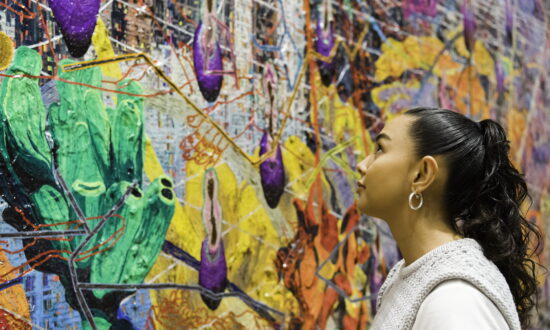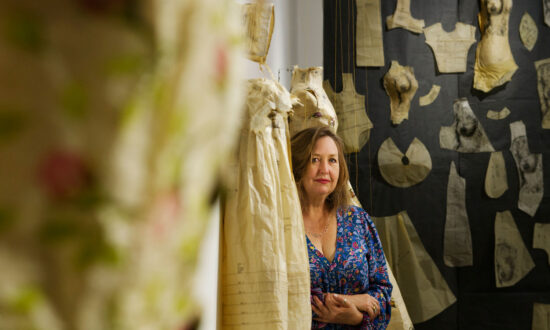Arthur Boyd: The Life of Saint Francis
The David Roche Foundation House Museum
Arthur Boyd is considered one of Australia’s most prominent artists, painting lyrical and emotive allegories on themes such as love, loss and shame. His paintings frequently focus on notions of human behaviour and reference mythological and biblical stories.
Boyd was particularly drawn to outsiders, so his interest in the original thinker, St Francis of Assisi, is not surprising. Arthur Boyd: The Life of Saint Francis, currently showing at the David Roche Foundation House Museum, highlights his vision of the medieval Italian saint through a series of rarely seen tapestries.
In 1975, Boyd left an enduring legacy to the National Gallery of Australia (NGA) of more than 2000 works of art, including several drawings and lithographs. In the same year, the NGA acquired the St Francis tapestries. Drawing on this collection and curated by museum director Robert Reason, the exhibition presents 12 of Boyd’s large and spectacular tapestries depicting the life of the saint, alongside pastels and lithographs.
Reason has curated an impressive exhibition that gives the viewer insight into the artist’s practice as well as his interest in St Francis.
“The tapestries hardly ever get out on display and I was keen to have the opportunity to show them here in Adelaide, where they hadn’t been shown before,” he says. “They are such an under-represented and under-known part of Boyd’s work.”

The Arthur Boyd exhibition at David Roche Foundation House Museum includes pastels and lithographs alongside the large tapestries. Photo: supplied
Francis of Assisi, one of the Catholic Church’s most venerated and beloved saints, is known for his ministry to the poor and underprivileged, his care for nature and animals, and for founding the Franciscan order. Boyd’s interest in the Italian saint began soon after his move to London in 1959 and continued during his subsequent travels throughout Europe in 1960.
The artist was particularly taken by Italy and returned in 1964 to visit the towns of Assisi and Gubbio, after which he began his depiction of the spirit of St Francis through a series of pastel drawings. He then created a set of lithographs which were later used to illustrate the 1968 edition of art historian Tom Boase’s biography of the saint.
Boyd worked across many different media and, following his experiments in pastels and prints, he was encouraged by fellow artist John Olsen to translate his works into tapestries. These tapestries depict the lesser-known aspects of St Francis’s life, focussing on his rejection of wealth and status in favour of a spiritual life.

Arthur Boyd, St Francis when young dreaming of fine clothes and amour.
Woven between late 1970 and 1974 at the Tapeçarias de Portalegre atelier in Portugal, under Boyd’s direction, the works are immediately impressive due to their scale. Each tapestry measures 2.5m x 3m and has a density of 2500 stitches per square metre.
The exhibition is well-curated and the layout allows audiences to fully absorb the grandeur of the tapestries, while also appreciating the accompanying pastels and lithographs. It begins with tapestries that examine Francis’s childhood. For example, St Francis when young dreaming of fine clothes and amour depicts the saint grappling with the decision to follow God rather than the family business.

Arthur Boyd, St Francis being beaten by his father.
The exhibition moves onto St Francis’s spiritual life with the striking tapestry St Francis being beaten by his father, indicating his father’s reluctance to accept him choosing a life of God. Other tapestries highlight his relationship with St Clare, which particularly fascinated Boyd, and here he uses his artistic licence to expand the story of St Francis beyond iconographic tradition. Boyd was also fascinated with the legend of the Wolf of Gubbio and several tapestries follow this myth.

Get InDaily in your inbox. Daily. The best local news every workday at lunch time.
St Francis lying in the flames is a stunning tapestry that stands out as the scene of the temptation of the flesh, portrayed at night. The image is depicted in rich hues of purple and black, and is a contrast to the other tapestries. The last tapestry on display, St Francis removing the rosary, highlights Boyd’s original interpretation of the story of the life of St Francis, as it is not part of the legend.

Arthur Boyd, St Francis lying in the flames.
Arthur Boyd: The Life of Saint Francis is a fascinating exhibition that audiences which needs to be visited in person to fully appreciate the depth, vibrancy and scale of these incredible tapestries.
“It remains the largest single suite of tapestries made by an Australian artist,” says Reason. “It’s a really significant series that doesn’t get shown because of its scale and size. We weren’t able to show the whole suite but I feel they are too good to be tucked away in storage all the time.”
Arthur Boyd: The Life of Saint Francis is showing at the David Roche Foundation House Museum until September 2.
Support local arts journalism
Your support will help us continue the important work of InReview in publishing free professional journalism that celebrates, interrogates and amplifies arts and culture in South Australia.
Donate Here




